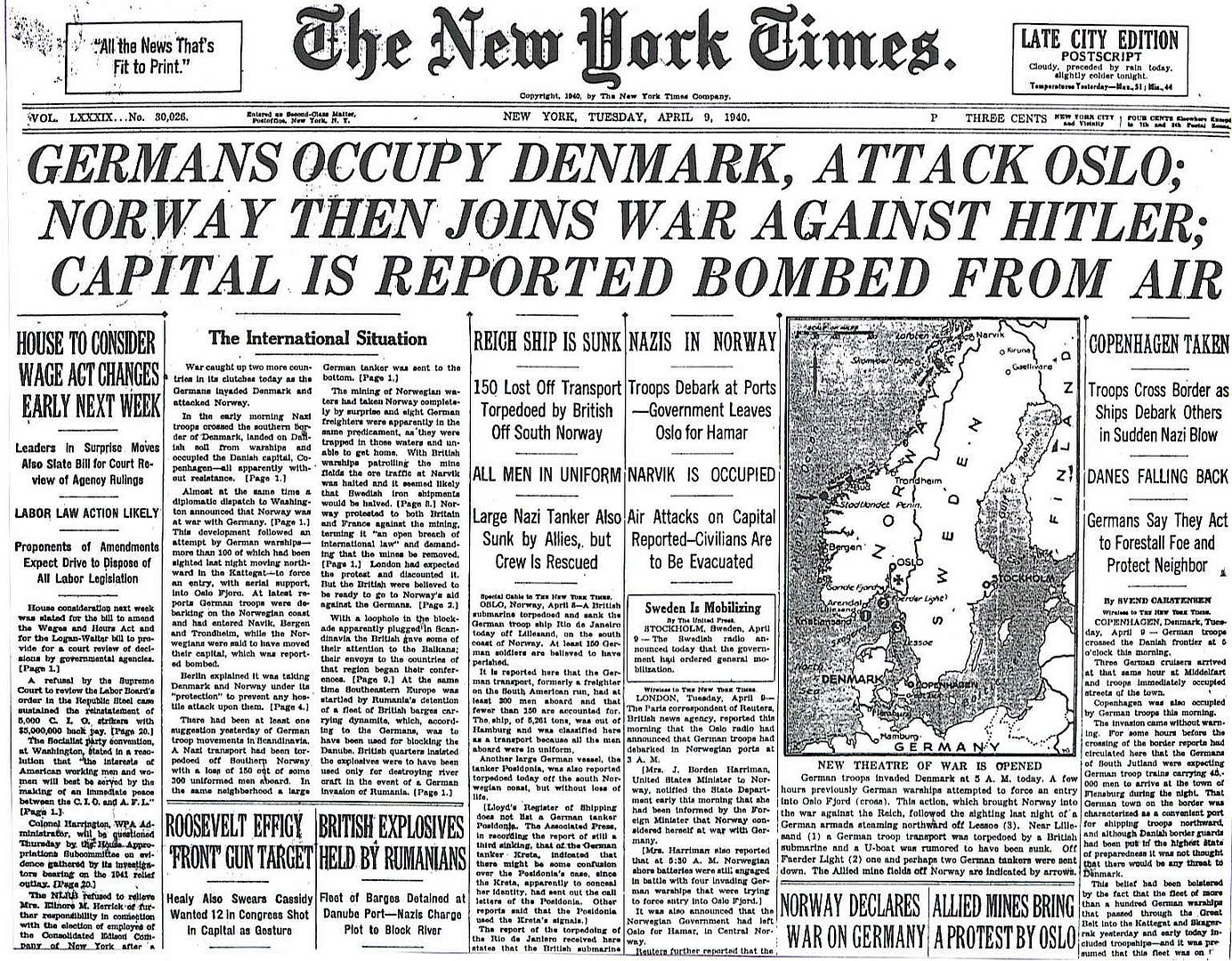
Posted on 04/09/2010 4:35:31 AM PDT by Homer_J_Simpson

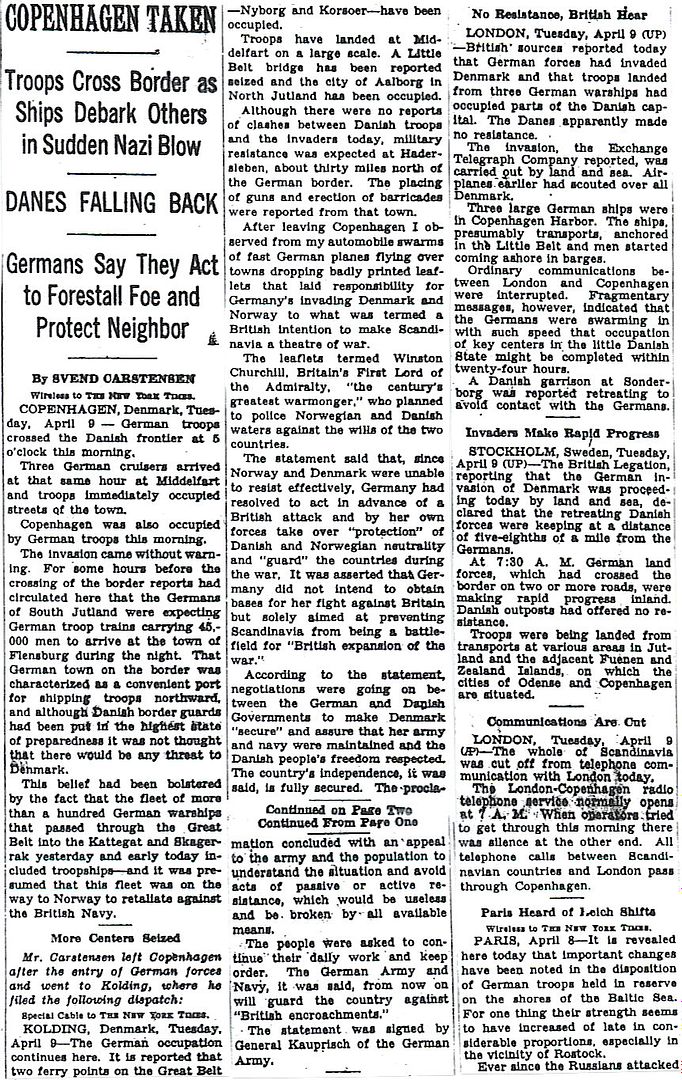

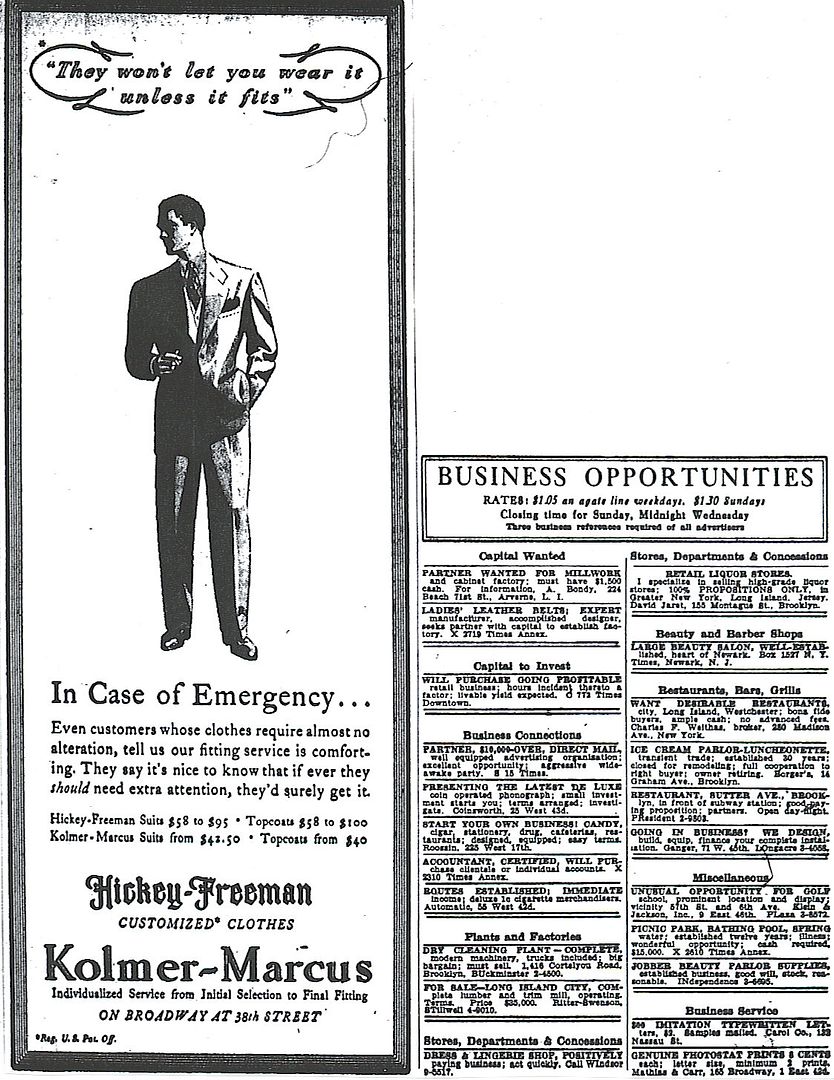
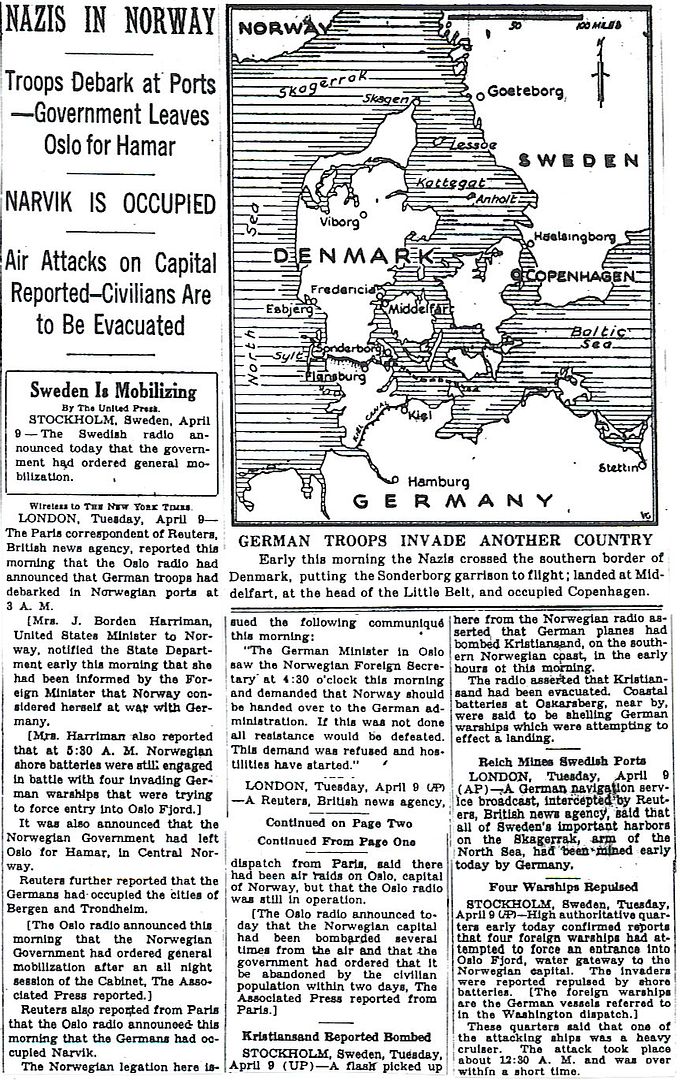
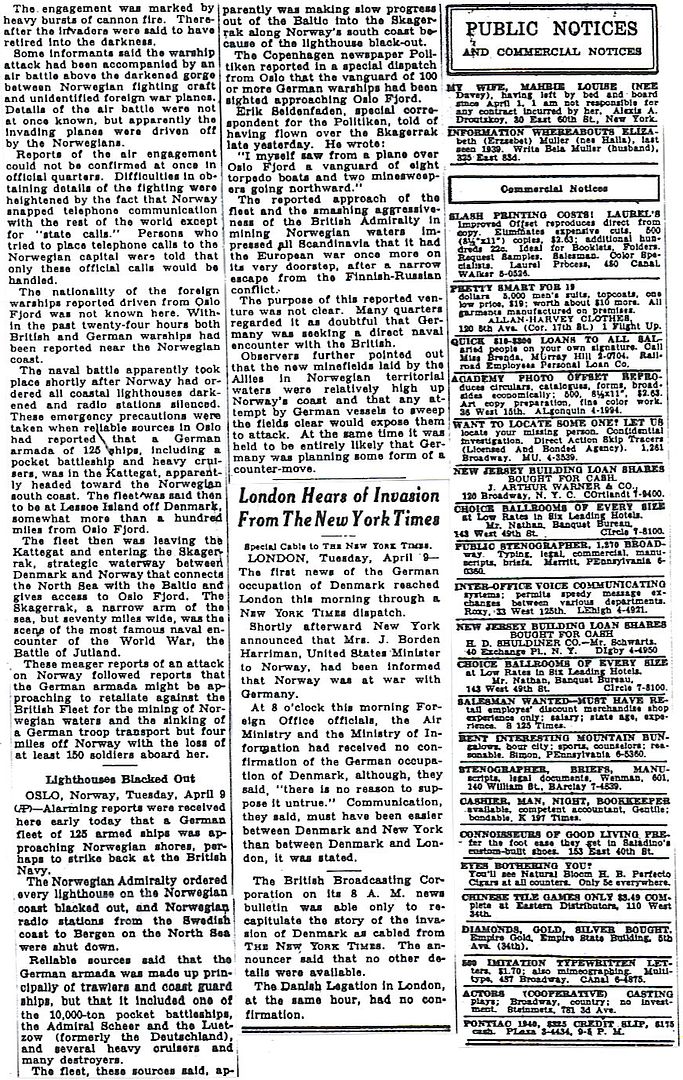

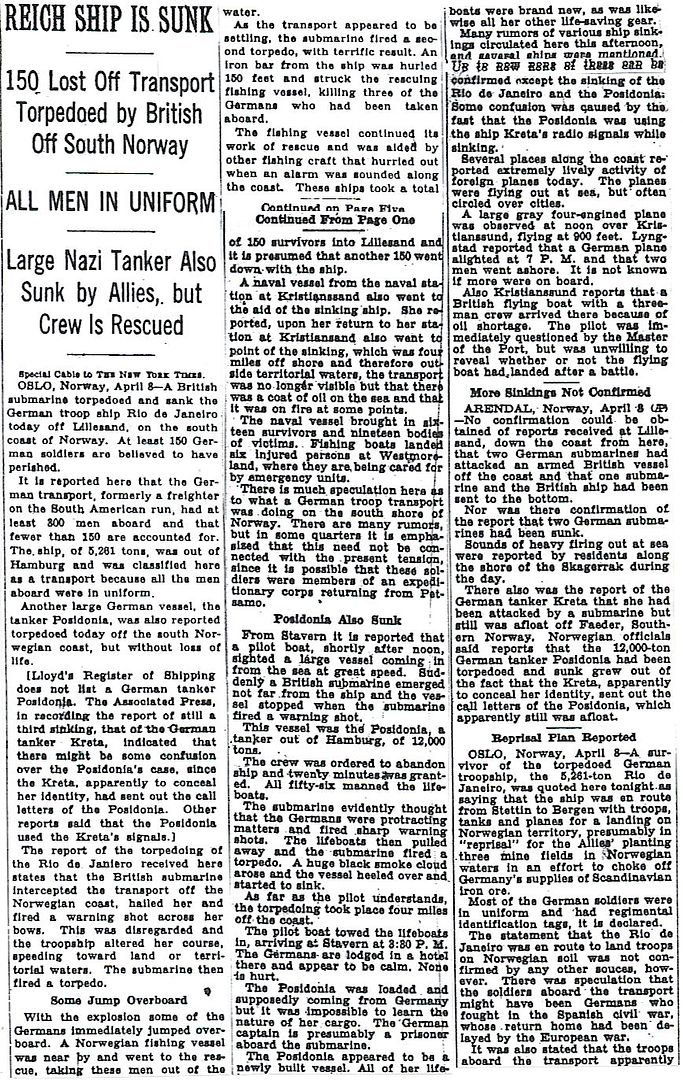
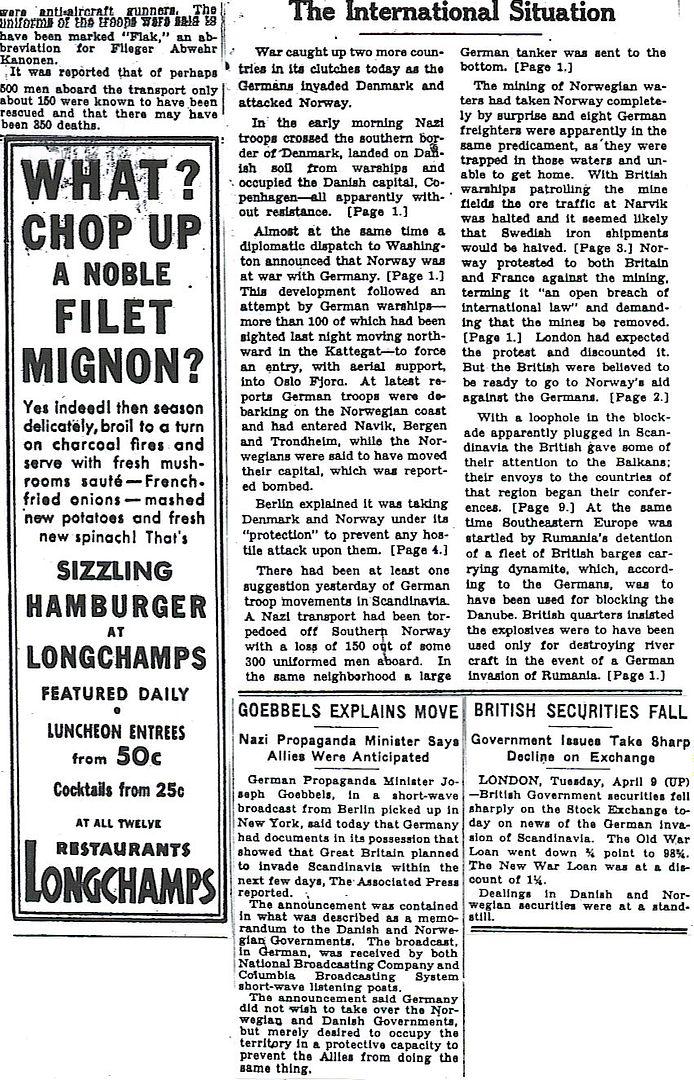
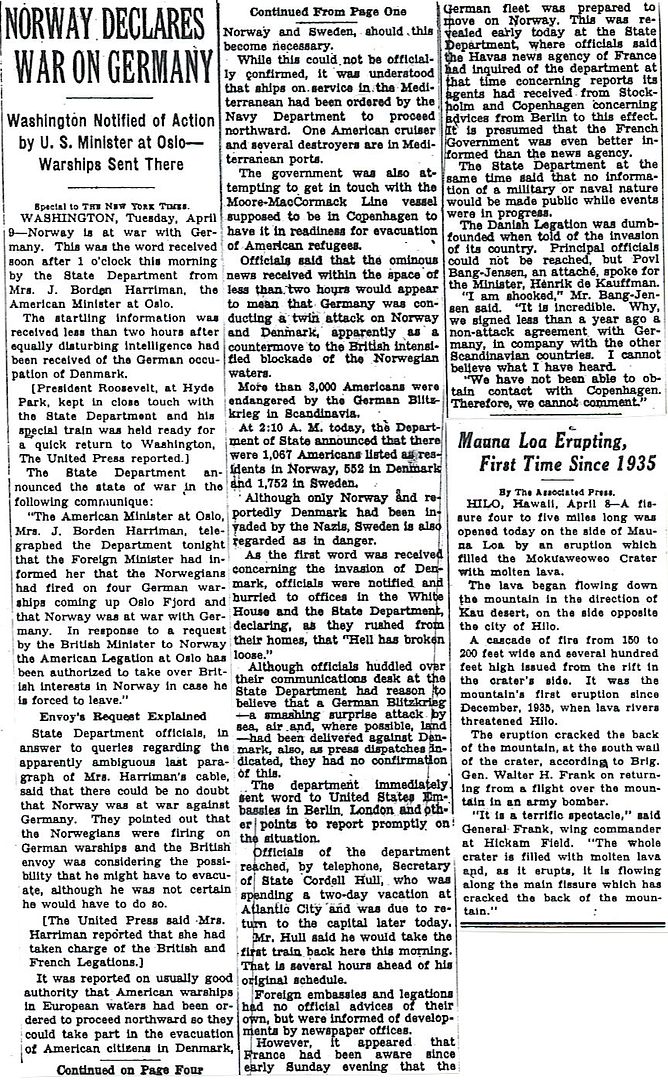
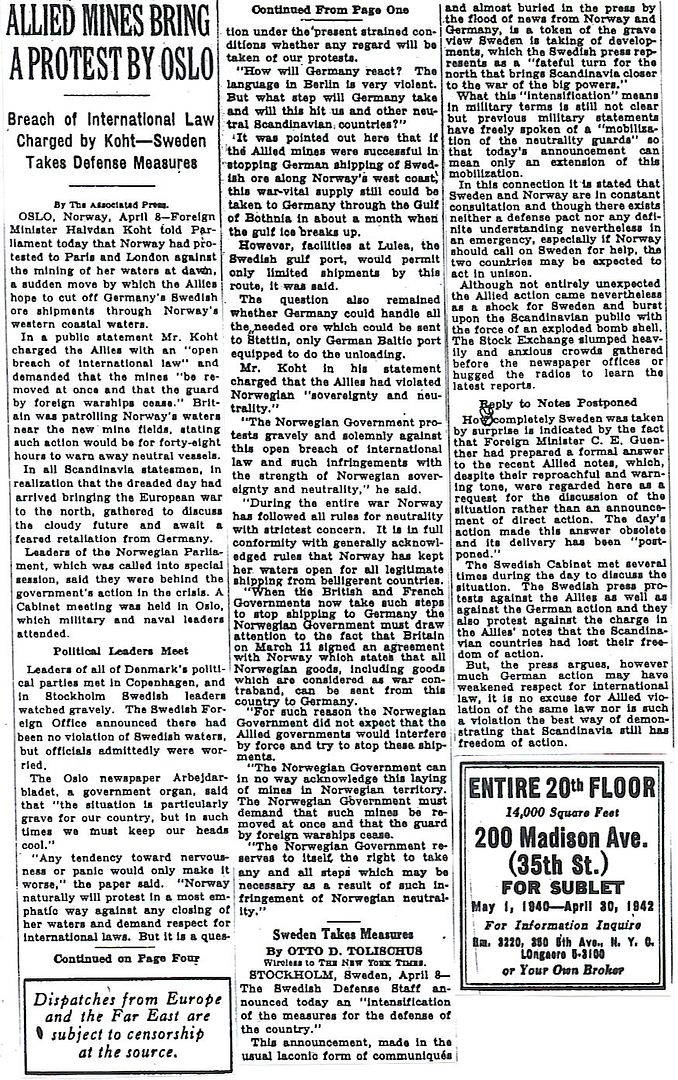
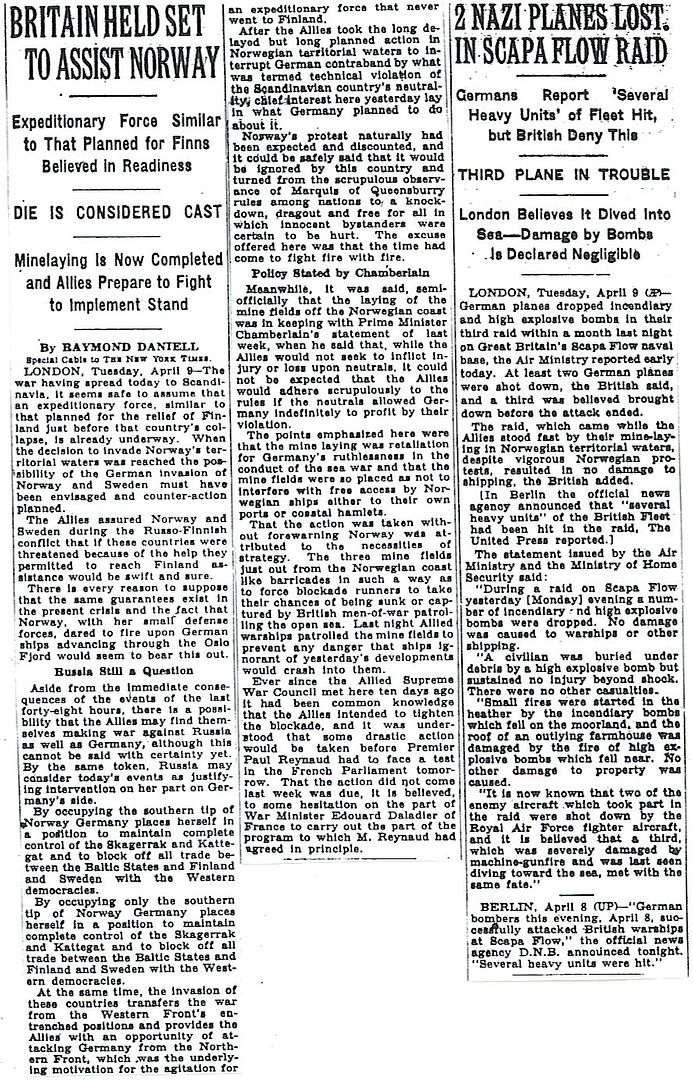
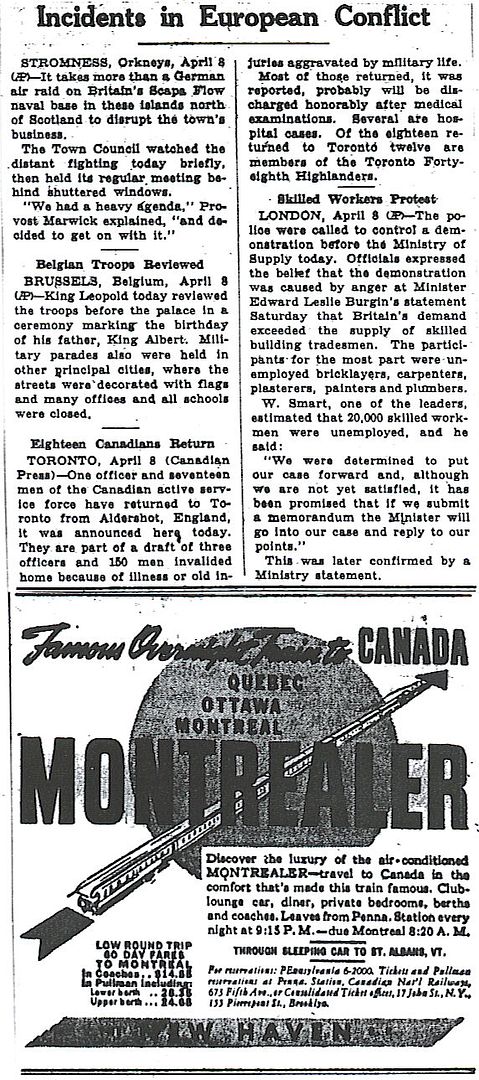
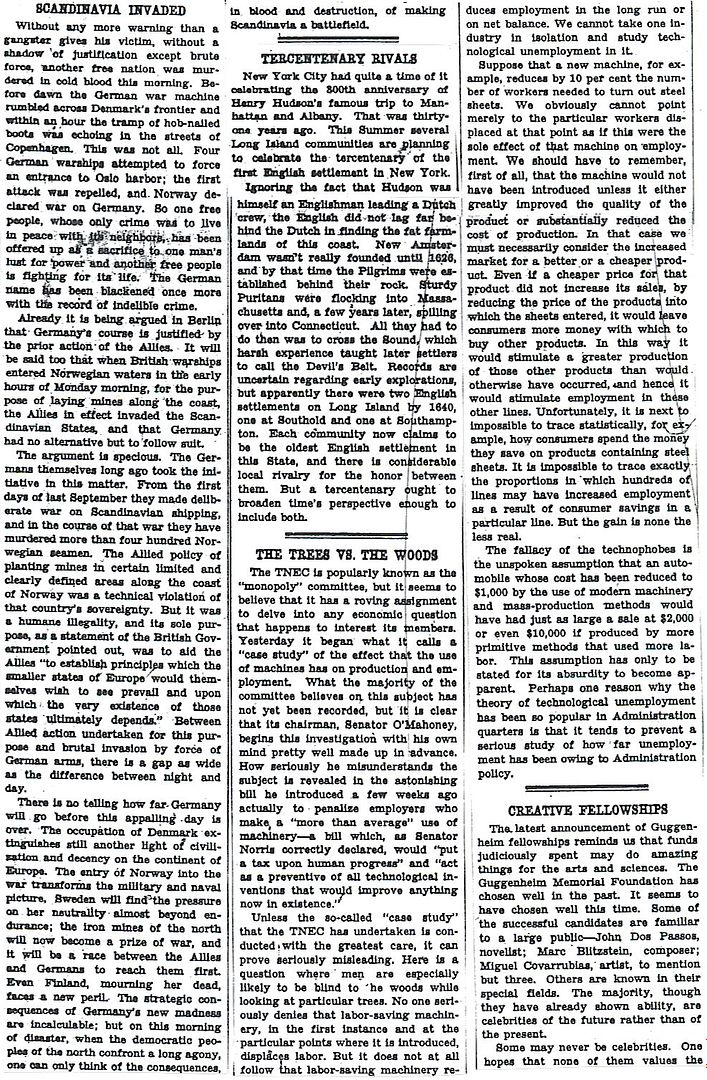
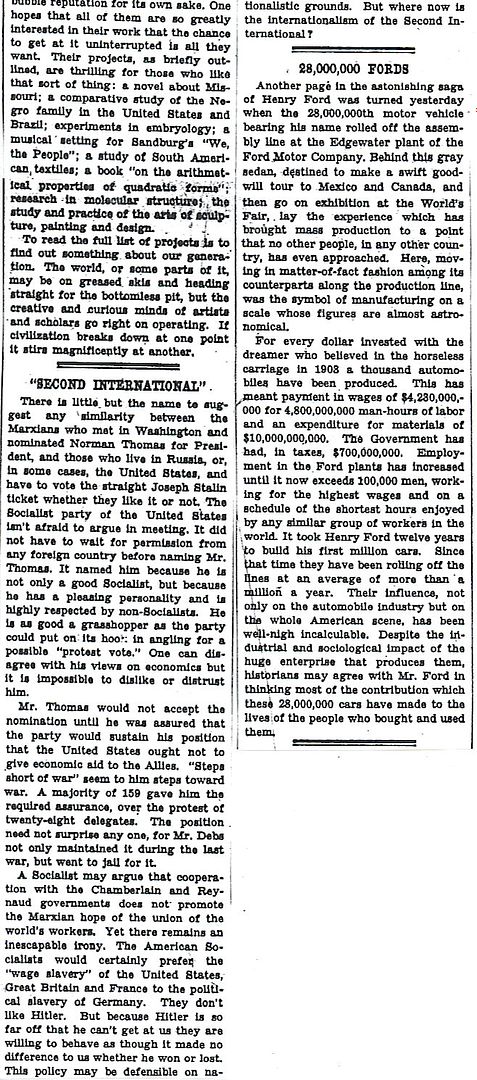
Editorials – 14-15
Scandinavia Invaded
Tercentenary Rivals
The Tree vs. the Woods
Creative Fellowships
“Second International”
28,000,000 Fords
All this confusion... I’m gonna report you to the FRee Republic Posting Police!
(Just Kidding, LOL!!)
http://www.onwar.com/chrono/1940/apr40/f09apr40.htm
Germans invade Denmark and Norway
Tuesday, April 9, 1940 www.onwar.com
German infantry bicycle into CopanhagenIn Denmark... Two German divisions under the command of General Kaupitsch invade Denmark as part of Operation Weserübung. Copenhagen is taken within 12 hours.
In Norway... The German landings in Norway begin as part of Operation Weserubung. The group of ships intended for Oslo meet increasing resistance as they sail up the Oslo Fiord. At the Oscarsborg Narrows the brand-new heavy cruiser Blucher is sunk. The troops are compelled to land below this point but are, however soon in the town. Airborne units take some casualties in a simultaneous landing at Oslo airport. Fog disrupts the German landings at Kristiansand but eventually the troops get ashore. At Stavanger the vital airfield is quickly taken by airborne attack but much of the airborne force’s equipment is sunk offshore by a Norwegian destroyer. At Bergen surprise is also achieved but the cruiser Konigsberg is damaged by a coastal battery. To the north, Trondheim is taken practically without a shot. The most questionable part of the German plan is the move on Narvik. By a combination of luck and bad weather they pass the British patrols en route and once up the fiord quickly sink the two old coast-defense ships. Offshore there is an engagement between the battlecruiser Renown and Scharnhorst and Gneisenau in which, despite the disparity of force, Gneisenau is damaged before the German ships break off the action. A British destroyer force is on the way to Narvik. Off Kristiansand the cruiser Karlsruhe is sunk by a British submarine. Overall the Germans have succeeded in getting their forces ashore and their established control of Stavanger airport will prove crucial. German airpower is already restricting British operations, having sunk one destroyer and damaged the battleship Rodney.
Dark days ahead for the Kriegsmarine.
http://www.onwar.com/chrono/1940/apr40/f09apr40.htm
Germans invade Denmark and Norway
Tuesday, April 9, 1940 www.onwar.com
German infantry bicycle into CopanhagenIn Denmark... Two German divisions under the command of General Kaupitsch invade Denmark as part of Operation Weserübung. Copenhagen is taken within 12 hours.
In Norway... The German landings in Norway begin as part of Operation Weserubung. The group of ships intended for Oslo meet increasing resistance as they sail up the Oslo Fiord. At the Oscarsborg Narrows the brand-new heavy cruiser Blucher is sunk. The troops are compelled to land below this point but are, however soon in the town. Airborne units take some casualties in a simultaneous landing at Oslo airport. Fog disrupts the German landings at Kristiansand but eventually the troops get ashore. At Stavanger the vital airfield is quickly taken by airborne attack but much of the airborne force’s equipment is sunk offshore by a Norwegian destroyer. At Bergen surprise is also achieved but the cruiser Konigsberg is damaged by a coastal battery. To the north, Trondheim is taken practically without a shot. The most questionable part of the German plan is the move on Narvik. By a combination of luck and bad weather they pass the British patrols en route and once up the fiord quickly sink the two old coast-defense ships. Offshore there is an engagement between the battlecruiser Renown and Scharnhorst and Gneisenau in which, despite the disparity of force, Gneisenau is damaged before the German ships break off the action. A British destroyer force is on the way to Narvik. Off Kristiansand the cruiser Karlsruhe is sunk by a British submarine. Overall the Germans have succeeded in getting their forces ashore and their established control of Stavanger airport will prove crucial. German airpower is already restricting British operations, having sunk one destroyer and damaged the battleship Rodney.
9 posted on Friday, April 09, 2010 6:40:40 AM by abb (”What ISN’T in the news is often more important than what IS.” Ed Biersmith, 1942 -)
[ Post Reply | Private Reply | To 1 | View Replies | Report Abuse]
To: Homer_J_Simpson
http://homepage.ntlworld.com/andrew.etherington/month/thismonth/09.htm
April 9th, 1940
NORWEGIAN CAMPAIGN.
The German Norwegian Invasion begins. Landings at Oslo, Bergen, Kristiansand, Trondheim and Narvik. Parachute troops are used at Oslo.
Norwegian forces resist strongly.
At Narvik, the 40 year old ironclads “Eidsvold” and “Norge” are ordered to resist any attack by force, but both are sunk by torpedoes from destroyer “Wilhelm Heidekamp”. (Alex Gordon)
The German Cruiser Königsberg is damaged near Bergen by coastal batteries.
Cruisers “Königsberg” and “Köln” are leading the Group 3 invasion forces to Bergen. The German Navy were regarding this part of the operation as particularly dangerous since Bergen was only 8 or 9 hours sailing time from Britain and they expected that major units of the British Fleet would be waiting for them. In fact the British had no elements stationed off Bergen and the German ships were able to make their approach without any opposition. However, Norwegian Defence forces under Admiral Tank-Nielsen were alert and prepared for action, as the Admiral had reckoned on the German likely reaction to the laying of mines off Narvik by the British Navy the previous day.
He sent two minelayers to lay mines blocking the approaches to the town from both north and south, and stationed some torpedo boats and patrol craft in the same approaches. He alerted coastal forts, extinguished coastal lighting and requested the local army commander to supply infantry for the town’s defence, and the air force to make reconnaissance patrols at first light, and Bergen was blacked out.
A coastal lookout reported the German invasion fleet heading towards Bergen from the south just after 0100, but when one of the torpedo boats found itself in a suitable position from which to launch an attack, it held back when its commander saw the overwhelming firepower of the oncoming German ships. As the ships came within range of the main fortress, the commandant ordered the searchlights to be turned on, but they were unable to do so, because their electrical power came from the town supply which had been turned off when the blackout was ordered. The fortress gunners were able to identify silhouettes of the German warships, but held fire as two cargo ships sailed through the firing zone, and “Köln” sailed past the fort and made port in Bergen. The fortress gunners then opened fire on the German ships bringing up the rear of the invasion force and hit the supply ship “Bremse” and seriously damaged “Königsberg”, but as the Norwegian infantry failed to arrive, the city fell to the Germans with little resistance. (Alex Gordon)
Germans capture the airfield at Stavanger and put their aircraft to good use.
German Navy forces include a pocket battleship, six cruisers and 14 destroyers for the landings at the five Norwegian ports, with battlecruisers Scharnhorst and Gneisenau (under the command of Vice-Admiral Günther Lütjens) covering the two most northerly ones. Thirty U-boats patrol off Norway and British bases, but throughout the campaign they suffer from major torpedo defects.
Around 0400 HMS Renown is in action with the two battlecruisers to the west of Vestfjord (some 50 miles off Narvik). In a brief exchange of fire the Gneisenau receives three 38cm hits and is damaged and HMS Renown is slightly damaged by two 28cm hits. The Germans withdraw. (Navy News)
Around the same time the occupation forces heading for Oslo come under heavy fire from Norwegian coastal defences. Heavy cruiser Blucher and the torpedo boat Albatross are sunk by guns and torpedoes in the Oslofjord.
Entering the Oslofjord at midnight, the German squadron led by Blücher and Lützow is spotted and challenged by the Norwegian armed whaler POL III which is sunk by gunfire from a German torpedo boat. Shortly after, the German squadron passed two small forts which attempted to engage the Germans but were hindered by heavy fog. Both POL III and the forts advise Oslo sea defence district that they are under attack.
At approx 0400 the new German heavy cruiser “Blücher” carrying Rear-Admiral Kummetz, General Erwin Engelbrecht and 1000 troops of the 163rd. Infantry Division followed by Panzerschiffe Lützow approaches the Drøbak Narrows in the Oslo Fjord. The Oscarsborg fortress (which was regarded as the strongest fortress in Europe when it was built at the time of the Crimean War) was in darkness, and Admiral Kummetz assumed that there would be no resistance. A searchlight on the opposite shore to the fortress illuminated the German warship and the fortress immediately opened fire with its 1905 Krupp 28 cm. guns to good effect. Blücher was set on fire but continued forward, until almost immediately it came within range of the Austrian-built torpedo battery and was hit by two of the torpedoes. This set her fate, and about two hours later Blücher rolled over and sank. Admiral Kummetz and General Engelbrecht were able to swim ashore and made prisoners by the Norwegians. The command of the invasion fleet then passed to the commander of Lützow who ordered the fleet to turn back, and landed the troops further back down the fjord about 50 miles from Oslo.
The torpedo boat “Albatros” is also sunk in the Oslo Fjord. (Alex Gordon)
Norwegian coastal defence ships Eidsvold and Norge are sunk at Narvik. The Norwegian Ægir is sunk at Stavanger and Tor is sunk at Frederikstad.
When the German invasion of Norway began, the Royal Navy was quick to respond, sending the Home Fleet to sea to support its other elements at sea and to, hopefully, crush the Kriegsmarine forces involved. One of the ships dispatched to join the gathering forces was the sole Royal Navy carrier in home waters, HMS Furious, escorted by the destroyers, HMS Maori, HMS Ashanti, and HMS Fortune. Unfortunately for future operations, Furious, which had been in the Clyde after completing a refit, had only been able to land-on her two Swordfish TSR Squadrons, 816 and 818. Her presence with the fleet being considered a necessity, the Admiralty refused permission for the ship to close the Orkneys to embark her Skua equipped fighter-dive bomber Squadron, 801, then at Evanton in Scotland. Thus, when she joined the fleet off Trondheim on 10 April, she embarked but 18 Swordfish and no fighters. (Mark Horan)
A Home Fleet cruiser force is detached to attack the German warships in Bergen, but is soon ordered to withdraw. As they do they come under sustained air attack and Tribal Class destroyer HMS Gurkha, which is screening other units of the Home Fleet is bombed and sunk south-west of Bergen at 59 13N, 04 00E when she is attacked by a mixed force of Ju.87 and He.111 dive bombers. There are 190 survivors. This is the first loss of a Tribal class destroyer and the first loss of a British destroyer to air attack. (Alex Gordon)(108) HMS Rodney is damaged by German air attack.
In the evening German cruiser Karlsrühe leaves Kristiansund and is torpedoed by submarine HMS Truant. She has to be scuttled the next day.
Three Heinkel 111 units of KGs 4, 26 and 100 performed ‘demonstration flights’ and leaflet raids with some bombing of Oslo-Kjeller airfield and flak positions. All three Gruppen of KG30(Ju88) take part.
Luftwaffe: 41 bombers of KG 26 in company with Ju88s of KG30 attack Royal Naval units, damaging cruisers HMS Devonshire, Glasgow and Southampton and sinking the destroyer HMS Gurkha.
Three fighter Gruppen of ZG1 and ZG76 (Bf110C) take part as the fighter cover.
German troops under General Nikolaus von Falkenhorst have been landed in every Norwegian port as far north as Narvik.
(Mark Horan and Alex Gordon)
DENMARK:
Major-General Eduard Dietl’s Mountain Division and the Luftwaffe’s First Parachute Regiment go in as the spearhead of this invasion. The main German army is under General Kaupitsch. Hardly a shot has been fired.
The invasion began as 5am when three troopships sailed into Copenhagen harbour. A lone policeman who resisted the invaders with a pistol fell, and the city is taken without further fighting.Trawlers escorted by E-boats then brought troops into all Denmark’s ports and major islands, giving them control of the vital sea passages, the Skagerrak and the Kattegat, between Denmark and Norway. Airborne troops land at Aalborg airfield and motorised troops cross Denmark’s land frontier at Flensburg and Tondern. At Gjedser a ferry came in ferrying troops and an armoured train.
After 16 Danish deaths King Christian X ordered a cease-fire at about 6am. The Danish C-in-C General Pryor ignored the order, then at 6.45am, the King sent his personal adjutant to ensure that it was obeyed.
The occupation puts Germany in an unprecedented legal position. Since Denmark did not resist, Denmark is not at war with Germany. It is still neutral. The Germans are faced with a coalition government embracing most Danish democratic parties which they cannot depose without undermining their claims, however tenuous, of not threatening other neutral nations.
The Danish Air Force flew one mission today when a Fokker CV from 2. Squadron performed a reconnaissance along the Danish-German border. The onboard radio wasn’t working. The other CV which saw action was shot down right after take-off by a BF 110 Both airmen (Godfredsen and Brodersen) was killed. (Per Biensø)
Detailed description of today’s events in Denmark.
GERMANY:
The Wehrmacht High Command announced:-
Operations for the occupation of Denmark and the Norwegian coast, went according to plan on April 9. No incidents occurred anywhere during the landings and entry into Denmark. On the coast of Norway, notable resistance was offered only in Oslo; this was broken in the afternoon hours. Oslo itself has been occupied.
BELGIUM: The British and French governments ask for permission for their troops to enter the country; the government refuses. (Jack McKillop)
U.S.A.: The Joint Planning Committee of the Joint Board submits a new general estimate of the world situation in relation to American defence and preparations for war. This is part of the revision of existing plans, and for developing or completing new plans for the rainbow series. Formulators of the rainbow plans envision multiple, simultaneous enemies, instead of individual enemies each designated by a single color, e.g., ORANGE stands for Japan. (Jack McKillop)
http://worldwar2daybyday.blogspot.com/
Day 222 April 9, 1940
At 5 AM, Germany invades Denmark & Norway. Denmark is taken by surprise & surrenders immediately after unopposed landings in Copenhagen & threats of bombing.
Germans warships land troops at 4 main points in Norway. At Narvik, German destroyers sink Norwegian coastal cruisers Eidsvold & Norge (276 lives lost, 98 survivors). Trondheim is captured easily as the Germans sail past the coastal batteries (pretending to be British warships). At Bergen, Kvarven Fort’s batteries damage cruiser Königsberg & minelayer Bremse. At Oslo, Oscarsborg Fortress’ batteries & shore torpedoes sink German cruiser Blücher in the Oslofjord (830 dead, 1370 swim ashore) and cruiser Lützow is also shelled but escapes. The delayed landing of troops allows Norway’s Royal Family, Government and gold reserves to escape Oslo at 8.30 AM. Oslo is captured later in the day by German troops airlifted into Fornebu Airport. Stavanger and Sola Airfield are also taken by German paratroops.
The shipment of Norway’s gold reserve from Oslo on the morning of 9 April 1940 consisted of 818 cases weighing 40 kilos each, 685 cases weighing 25 kilos each and 39 kegs weighing 80 kilos each. The total shipment weighed 53 tonnes whereas the gold bars weighed about 48.8 tonnes. http://www.dokpro.uio.no/umk_eng/blanding/gullbehold.html
Naval action around Norway.
At dawn, British cruiser HMS Renown spots German battleships Scharnhorst and Gneisenau heading West, having deposited Marine Gruppe 1 at Narvik. Renown fires first and scores 3 hits on Gneisenau. HMS Renown is hit twice before the German ships use their superior speed to escape. All ships survive the encounter. The westward course of the German battleships further convinces the Admiralty that the Kriegsmarine is attempting to breakout into the Atlantic Ocean.
Afternoon, Luftwaffe searches for Royal Navy ships, finding the Home Fleet and 1st Cruiser Squadron that are still searching for the Kriegsmarine’s “Atlantic breakout”. At 2 PM, Ju 88s and He 111s bomb battleship HMS Rodney and destroyer HMS Gurkha off Bergen. HMS Rodney is damaged by a 500 kg bomb that penetrates her deck but does not explode. HMS Gurkha is hit (15 dead) and eventually sinks at 4 PM after cruiser HMS Aurora picks up 190 survivors. 4 Ju 88s are shot down.
At 5 PM, British submarine HMS Thistle misses U-4 with a spread of four torpedoes trying to sneak into Stavanger.
Vice-Admiral Horton’s hunch pays off and his submarines are in position to attack German warships. At 7.57 PM, HMS Truant is patrolling in the Skagerrak and torpedoes German cruiser Karlsruhe. Karlsruhe does not sink and is finished off at 9.50 PM by the German torpedo boat Greif. Meanwhile, French submarine Sybille (under Horton’s command) departs Harwich to patrol the south North Sea, West of Denmark.
I think this was when it actually started to sink in that things were going to get REALLY BAD.
By then, Raeder was urging a Mediterranean strategy. But Hitler had his eyes fixed elsewhere.
Although it’s way more than 70 years ago, today is also the anniversary of the Battle of Liegnitz [1241], which, coupled with the battle of Mohi [April 11th], completed phase one of the Mongols’ invasion of Europe, the military neutering of Poland, and Bohemia, and the occupation of Hungary up to the Danube.
Thought I’d mention it, since I have a hunch the only military campaign it surpasses may be starting soon.
Hitler was a true “landlubber.” While he had some understanding of the value of submarine warfare, he never really understood the need for a surface navy. Even though he visited KM Bismarck for a tour, he wasn’t comfortable on the ship. Thus, his surface fleet was neglected and as the war went on and his slender resources were stretched elsewhere, naval construction was wound down and some ships (such as Gneisenau) were scrapped.
While Weserubung gutted the surface fleet, it was a bold and daring operation conducted right under the nose of a superior foe. There is still considerable debate whether it was worth it. In the end, I have to think it was, for the reason it was implemented to begin with: Swedish iron ore. Germany had to have it, and if they didn’t secure it, the allies were going to deny it to them one way or another.
If you ever have some time for pure brain candy, this is a good read.
http://www.amazon.com/Gold-Crete-C-S-Forester/dp/0523009607
Gold From Crete
“Gold from Crete” is a wonderful collection of C.S. Forester’s shorter stories about World War II. It was published shortly after his death. Forester is, of course, best known as the creator of Horatio Hornblower, but he also wrote a number of other books, including some excellent stories of war at sea in the 20th century.
The final part of the book “If Hitler had invaded England” is a counterfactual history. Forester set out to explore what might have happened if, instead of waiting the Luftwaffe to secure air superiority over the RAF (which of course they never did), Hitler had ordered an invasion immediately after the Dunkirk evacuation on June 4th 1940.
Forester wrote this piece because a lot of people had said that if Hitler had invaded England in June 1940 he could have won the war, and Forester set out to analyse whether this was possible. He wrote in the preamble that Hitler “must be given every possible chance, but none of the impossible ones.”
Counterfactuals are ten a penny these days, but this was an unusual thing to write at the time: it compares very well with the many WWII counterfactuals which have been written over the following forty years.
You just reminded me of one of my favorites from when I was a yoot. I believe it was titled, "The Good Shepherd." It follows an American (?) destroyer on convoy duty on a trip across the Atlantic. I read it several times when I wasn't busy with Hornblower.
We might also mention, on Palm Sunday, April 9, 1865 General Robert E. Lee surrendered at Appomattox Court House to Union forces under US Grant.
That same day, Palm Sunday, in a battle in Alabama, one of my ancestors was shot in his palm -- crippled his hand so that he could no longer make a fist. It was the end of that war for him, and for the country.
But on April 9, 1940, WWII, "the Big One," is just getting started...
Thanks for the wonderful personal story. These really make the old histories come alive.
Wow. That is very interesting. Did he tell you any of the details of his sabotage work? I’d be interested in hearing about it.
Disclaimer: Opinions posted on Free Republic are those of the individual posters and do not necessarily represent the opinion of Free Republic or its management. All materials posted herein are protected by copyright law and the exemption for fair use of copyrighted works.